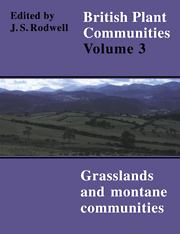Book contents
- Frontmatter
- Contents
- List of Figures
- Preface and Acknowledgements
- Preamble
- Mesotrophic Grasslands
- Community Descriptions
- Calcicolous Grasslands
- Community Descriptions
- Calcifugous Grasslands and Montane Communities
- Community Descriptions
- Index of Synonyms to Grasslands and Montane Communities
- Index of Species in Grasslands and Montane Communities
- Bibliography
U6 - Juncus Squarrosus-Festuca Ovina Grassland
Published online by Cambridge University Press: 04 July 2020
- Frontmatter
- Contents
- List of Figures
- Preface and Acknowledgements
- Preamble
- Mesotrophic Grasslands
- Community Descriptions
- Calcicolous Grasslands
- Community Descriptions
- Calcifugous Grasslands and Montane Communities
- Community Descriptions
- Index of Synonyms to Grasslands and Montane Communities
- Index of Species in Grasslands and Montane Communities
- Bibliography
Summary
Synonymy
Retrogressive Eriophoretum Adamson 1918 p.p.; Festuca-Juncus squarrosus grassland Ratcliffe 1959a; Juncetum squarrosi sub-alpinum McVean & Ratcliffe 1962; Juncus squarrosus bog McVean & Ratcliffe 1962 p.p.; Juncus-Vaccinium myrtillus nodum Welch 1967; Juncus-Carex nigra-Poly trichum commune nodum Welch 1967; Species-poor Juncus-Nardus nodum Welch 1967; Species-poor Juncetum squarrosi subalpinum Eddy et al. 1969; Species-poor Nardetum sub-alpinum, Juncus facies Eddy et al. 1969; Juncus squarrosus nodum Edgell 1969; Festuca ovina-Juncus squarrosus sociation Edgell 1969; Nardo-Juncetum squarrosi Birks 1973, Evans et al. 1977, Hill & Evans 1978, p.p.; Junco squarrosi-Festucetum tenuifoliae Birse & Robertson 1976, Birse 1980, 1984.
Constant species
Festuca ovina, Juncus squarrosus, Poly trichum commune, Lophocolea bidentata s.l.
Rare species
Barbilophozia lycopodioides.
Physiognomy
The Juncus squarrosus-Festuca ovina grassland includes most of the sub-alpine vegetation in which Juncus squarrosus occurs abundantly among a diversity of bog, grassland or heath associates. Early stages in colonisation can have a rather patchy cover of the rush and, in less favourable situations, it can remain more sparse, but typically it is at least co-dominant, and its tight, squarrose rosettes are often very numerous. Sometimes, the cover consists of colonies of various sizes, expanding marginally at a slow rate, clumps at Moor House of 4 m diameter being aged at over 160 years; in other cases, the sward is more uniform and sometimes quite dense. Each spring, new shoots burst out rapidly from among the old, bringing a flush of fresh glossy green to the herbage, after which the plants flower and the old foliage dies (Welch 19666).
The most usual co-dominants are grasses, particularly Festuca ovina, with F. vivipara occasionally distinguished at higher altitudes and, rather less commonly and not usually so abundant, Deschampsia flexuosa. Both of these can occur scattered among the J. squarrosus plants or as patches in mosaics with its clumps and, whereas the rush is generally ignored by grazing stock, these grasses are often cropped short, providing a valuable bite, particularly where the community occurs around the margins of bogs at higher altitudes. Other grasses are not quite so frequent, although Agrostis canina, particularly ssp. canina, is characteristic of wetter peats and, over poorly-drained peaty podzols, there is often some Nardus stricta, Agrostis capillaris and Anthoxanthum odoratum.
- Type
- Chapter
- Information
- British Plant Communities , pp. 368 - 378Publisher: Cambridge University PressPrint publication year: 1992
- 2
- Cited by

